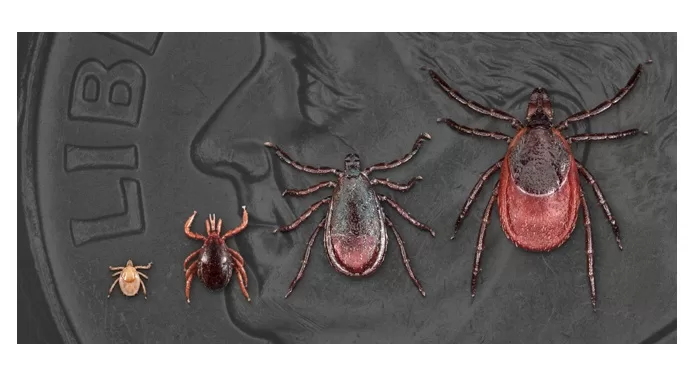Health
What is Lyme Disease? Symptoms, Diagnosis &Treatment

What is Lyme Disease? It is an infectious disease caused by the Borrelia bacterium which is spread by ticks. The most common sign of infection is an expanding red rash, known as erythema migrans, that appears at the site of the tick bite about a week after it occurred. The rash is typically neither itchy nor painful. Approximately 70–80% of infected people develop a rash. Other early symptoms may include fever, headache and tiredness. If untreated, symptoms may include loss of the ability to move one or both sides of the face, joint pains, severe headaches with neck stiffness, or heart palpitations, among others. Months to years later, repeated episodes of joint pain and swelling may occur. Occasionally, people develop shooting pains or tingling in their arms and legs. Despite appropriate treatment, about 10 to 20% of people develop joint pains, memory problems, and tiredness for at least six months.
What’s covered in the article:
-
Most people are infected when they go outdoors in wooded areas where Lyme disease is common and are bitten by ticks infected with the bacteria Borrelia species.
-
Typically, a large, red spot appears at the site of the bite and slowly enlarges, often surrounded by several red rings.
-
Untreated, Lyme disease can cause fever, muscle aches, swollen joints, abnormalities of the electrical conduction system of the heart, and eventually problems related to brain and nerve malfunction.
-
The diagnosis is based on the typical rash and symptoms, exposure to ticks, and blood tests to detect antibodies to the bacteria.
-
Taking antibiotics usually cures the disease, but some symptoms, such as joint pain, may persist.
Lyme disease is transmitted to humans by the bites of infected ticks of the genus Ixodes. In the United States, ticks of concern are usually of the Ixodes scapularis type and must be attached for at least 36 hours before the bacteria can spread. In Europe, ticks of the Ixodes ricinus type may spread the bacteria more quickly. In North America, the bacteria Borrelia burgdorferi and Borrelia mayonii cause Lyme disease. In Europe and Asia, Borrelia afzelii and Borrelia garinii can also cause the disease.The disease does not appear to be transmissible between people, by other animals, or through food. Diagnosis is based upon a combination of symptoms, history of tick exposure, and possibly testing for specific antibodies in the blood. Blood tests are often negative in the early stages of the disease. Testing of individual ticks is not typically useful.
Prevention includes efforts to prevent tick bites such as by wearing clothing to cover the arms and legs, and using DEET-based insect repellents. Using pesticides to reduce tick numbers may also be effective.Ticks can be removed using tweezers. If the removed tick was full of blood, a single dose of doxycycline may be used to prevent the development of infection, but is not generally recommended since the development of infection is rare. If an infection develops, a number of antibiotics are effective, including doxycycline, amoxicillin, and cefuroxime. Standard treatment usually lasts for two or three weeks. Some people develop a fever and muscle and joint pains from treatment which may last for one or two days. In those who develop persistent symptoms, long-term antibiotic therapy has not been found to be useful.
Transmission
Lyme disease is classified as a zoonosis, as it is transmitted to humans from a natural reservoir among small mammals and birds by ticks that feed on both sets of hosts. Hard-bodied ticks of the genus Ixodes are the main vectors of Lyme disease (also the vector for Babesia). Most infections are caused by ticks in the nymphal stage because they are very small and thus may feed for long periods of time undetected. Nymphal ticks are generally the size of a poppy seed and sometimes with a dark head and a translucent body. Or, the nymphal ticks can be darker. (The younger larval ticks are very rarely infected.) Although deer are the preferred hosts of adult deer ticks, and tick populations are much lower in the absence of deer, ticks generally do not acquire Borrelia from deer, instead, they obtain them from infected small mammals such as the white-footed mouse, and birds.
Early Signs and Symptoms (3 to 30 Days After Tick Bite)
“Classic” Erythema Migrans Rash
- Fever, chills, headache, fatigue, muscle and joint aches, and swollen lymph nodes may occur in the absence of rash
- Erythema migrans (EM) ras
- Occurs in approximately 70 to 80 per cent of infected persons
- Begins at the site of a tick bite after a delay of 3 to 30 days (average is about 7 days)
- Expands gradually over several days reaching up to 12 inches or more (30 cm) across
- May feel warm to the touch but is rarely itchy or painful
- Sometimes clears as it enlarges, resulting in a target or “bull’s-eye” appearance
- May appear on any area of the body
- Does not always appear as a “classic” erythema migrans rash
Later Signs and Symptoms (days to months after tick bite)
Swollen Knee
Facial Palsy
- Severe headaches and neck stiffness
- Additional EM rashes on other areas of the body
- Facial palsy (loss of muscle tone or droop on one or both sides of the face)
- Arthritis with severe joint pain and swelling, particularly the knees and other large joints.
- Intermittent pain in tendons, muscles, joints, and bones
- Heart palpitations or an irregular heartbeat (Lyme carditis)
- Episodes of dizziness or shortness of breath
- Inflammation of the brain and spinal cord
- Nerve pain
- Shooting pains, numbness, or tingling in the hands or feet




















































